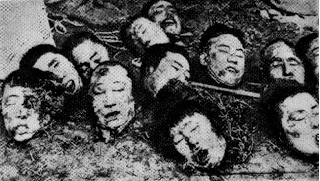••••••••••••••••••••WARNING: CONTAINS SOME GRAPHIC IMAGES••••••••••••••••••••

It always amazes me that there are still people who don’t believe that the Holocaust ever happened. The Nazis were meticulous in keeping records and kept a lot of data from the camps. Even Nazis like Oskar Gröning couldn’t believe Holocaust deniers.
Starting the post with one of the opening statements of the Nuremberg Trials.
Aside from the records held by the Nazis, there were, and still are, of course also eyewitness accounts, and the Allied troops recorded what they encountered.
Following is some evidence that was compiled by Robert Wolfe for a poster exhibit in 1990. also some evidence found by the allied forces.
“The other day I visited a German internment camp. I never dreamed
that such cruelty, bestiality, and savagery could really exist in this world!
It was horrible.
—Gen. Dwight D. Eisenhower to Mamie Eisenhower
Reims, April 15, 1945
I made the visit [to a German internment camp near Gotha, deliberately,
in order to be in position to give first¬hand evidence of these things if
ever, in the future, there develops a tendency to charge these allegations
I made the visit [to a German internment camp near Gotha, deliberately, in order to be in a position to give firsthand evidence of these things if ever, in the future, there develops a tendency to charge these allegations merely to ‘propaganda.’
—Eisenhower to Gen. George C. Marshall
April 15, 1945, Secret
When I found the first camp like that I think I never was so angry in my
life. I think people ought to know about such things. It explains some¬
thing of my attitude toward the German war criminal. I think the people at home ought to know what they are fighting for and the kind of person they are fighting.”
—Eisenhower to Pentagon Press Conference
June 18, 1945

in Mein Kampf, Hitler stated that his ultimate aim was the establishment of a new German empire, the Third Reich, which he envisioned as a contiguous, land-based state including all 80 million Germans and reaching from the Atlantic to the Urals.
The loss of Germany’s overseas colonies in World War I influenced Hitler’s view that German needs dictated expansion to the East. But more fundamentally the idea expressed an old belief common in Western thought: that to prosper and grow, a nation had to acquire more land and resources. Historically, many nations had sought to expand through conquest or colonization to provide for their growing populations. However, with the advent of industrialization and increasing commerce, rural agricultural life as the norm was progressively superseded in the urbanizing West, particularly in the 20th century. This trend was strongly opposed by the Nazis, who warmly embraced both the German peasant and rural ideal. In the face of a large population, highly developed industrialization, and increasing urbanization, the Nazi Party wanted to provide more Germans with the opportunity for farming. In one plan, for example, they aimed to resettle 8 million Germans in the East over a 30-year period. Rather than advocate limitation of population, redistribution of land within Germany, expansion of foreign trade, or domestic reform to make the new urban and industrial lifestyles more acceptable, the Nazis chose aggressive imperialism as their program. Their racism and planned aggrandizement in the East permitted them to avoid difficult political decisions at home. Racism and Hitler’s negative views on the multiethnic Austro-Hungarian empire led the Nazis to violently reject the possibility of coexistence with or assimilation of non-Aryans. Hitler rejected the possibility of transplanting Germanic colonists north, south, or west because these areas were densely populated by racially acceptable Europeans and the land in Scandinavia was too mountainous. Only eastward expansion into the vast agricultural plain that begins in central Poland and stretches through fertile Ukraine into European Russia would provide acceptable Nazi Lebensraum.
The main obstacle to this expansion was that the lands to the east were as heavily settled as those in Western Europe. Central and Eastern Europe was the home of over 200 million Slavs, a majority of Europe’s Gypsies, and 75 percent of Europe’s 8.5 million Jews. The fate of Eastern Europe’s inhabitants involved neither moral nor legal considerations because Nazi racial classification placed most of these people in subhuman alien outgroups Untermenschen which did not receive the same consideration as Aryans. In fact, these groups’ numbers, fertility, and supposed racial inferiority were seen as a direct threat to Aryans. The Nazis saw the survival of nations or races as a brutal social Darwinian struggle in which only “the fittest” survived or had a right to survive. Under the leadership of Heinrich Himmler, the Schutzstaffel (the SS) acquired responsibility for racial policies, resettlement, and colonization.

One of the primary documents used to calculate the number of deaths in the Nazi “euthanasia” program is this register (pictured above) discovered in a locked filing cabinet by US Army troops in 1945 at a killing site in Hartheim, Austria. The right page details by month the number of patients who were “disinfected” in 1940. The final column indicates that 35,224 persons had been put to death that year.
In a mass burial grave, the bodies of the dead children were found at a concentration camp at Nordhausen.

Civilians carry empty boxes up a hill to get the bodies of 120 victims killed by S. S. troops in a wooded area. They forced the townspeople to carry the bodies to the cemetery for proper burial. They spent two days building the boxes. Chaplains of the 3rd U. S. Army held short services for Protestant, Catholic, and Jewish victims.

Sources
https://www.loc.gov/item/93000410/
https://www.dla.mil/About-DLA/Images/igphoto/2002289758/










 .
.

















































You must be logged in to post a comment.